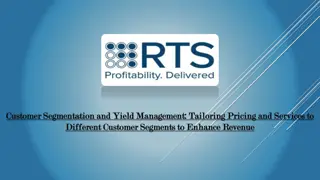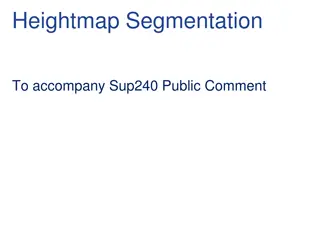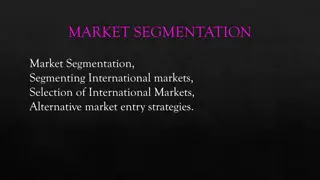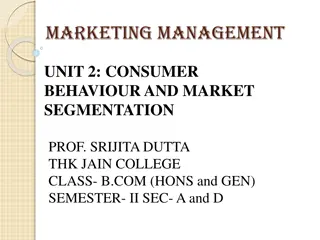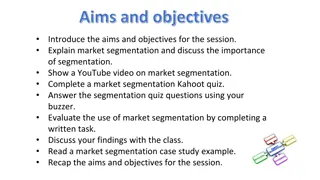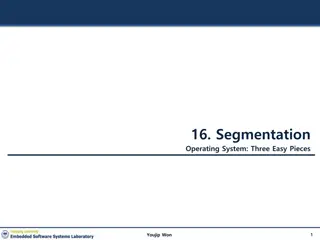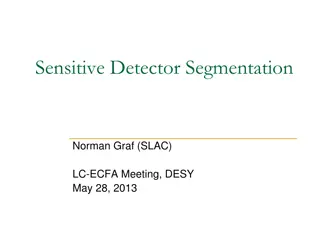
Understanding Marketing Segmentation and Positioning
Learn about marketing segmentation which involves dividing a market into smaller groups with distinct needs, characteristics, and behaviors. Explore market targeting, differentiation, and positioning to create superior customer value in the competitive landscape. Discover various segmentation strategies including geographic, demographic, and psychographic segmentation.
Download Presentation

Please find below an Image/Link to download the presentation.
The content on the website is provided AS IS for your information and personal use only. It may not be sold, licensed, or shared on other websites without obtaining consent from the author. If you encounter any issues during the download, it is possible that the publisher has removed the file from their server.
You are allowed to download the files provided on this website for personal or commercial use, subject to the condition that they are used lawfully. All files are the property of their respective owners.
The content on the website is provided AS IS for your information and personal use only. It may not be sold, licensed, or shared on other websites without obtaining consent from the author.
E N D
Presentation Transcript
Marketing Segmentation & Positioning
Marketing Segmentation Dividing a market into smaller groups with distinct needs, characteristics or behaviors who might require separate products or marketing mixes. Companies have moved from mass marketing to target marketing Companies look for different ways in which to segment the market and develops profiles of the resulting market segments.
Market Targeting The process of evaluating each market segments attractiveness and selecting one or more segments to enter Differentiation Actually differentiating the firm s market offering to create superior customer value Positioning Arranging for a product to occupy a clear, distinctive and desirable place relevant to competing products in the minds of target consumers
Geographic segmentation Dividing markets into different geographical units such as, nation, states, region, counties, cities or neighborhoods . Many companies localize their products, advertising, promotion, and sales efforts to fit the needs of individual regions, cities and even neighborhoods eg: Coke developed four ready to drink canned coffees for Japanese.
Demographic segmentation Dividing a market into groups based on variables such as age, gender, family size, family life cycle, income, occupation, education, religion, race, generation and nationality. Age and life-cycle segmentation: Dividing a market into different age and life-cycle groups eg: Anlene milk Gender Segmentation: Dividing a market into a different groups based on gender . eg: Nivea for men Income: Dividing a market into different groups based on social class, lifestyle, or personality characteristics. eg: Standard charted priority banking
Psychographic segmentation Dividing a market into different groups based on social class, life style or personality characteristics. eg: American Express My life My Card campaign provides a glimpse into the lifestyle of famous people
Behavioral Segmentation Dividing a market into groups, based on consumer knowledge, attitude, use or response to a product Occasions : Dividing a market into groups according to occasions when buyers get the idea to buy, actually make their purchase or use the purchase item. eg : Ginger beer with food Benefit sought: Dividing a market into groups according to the different benefits that consumers seek from the products. eg: Athletic wear segments based on functional benefits User status: Segment into non user, ex user, potential users, first time user and regular user. eg: P&G invites newly weds to visit pamper.com Usage rate: Segment based on usage, Light, Medium and Heavy users. eg: Sidhaleppa Loyalty Users : Divide groups based on there degree of loyalty. eg: Arpico privilege users
Segment Business Markets Consumers and business use many of the same variables to segment their markets. Business buys can be segmented geographically, demographically (Industrial and company size), or by benefit sought, user status or loyalty status. Business markets use additional variables, such as customer operating characteristics, purchasing approaches, situational factors and personal characteristics. eg: For small business customers, American Express has created the OPEN: Small Business Network, the one place that s all about small business
Segmenting International Markets Forming segment of consumers who have similar needs and buying behavior even though they are located in different countries. Teens show surprisingly similarity no matter where they live these teens could be from almost anywhere. Thus, many companies target teens with worldwide marketing campaigns Eg: Mercedes Benz targets the worlds well-to-do, regardless of their country.
Requirements for Effective segmentation Measurable: The size, purchasing power, and profiles of the segments can be measured. Accessible: Market segment can be effectively reached and served. Substantial: The market segments that are large or profitable enough to serve. Differentiable: The segments are conceptually distinguishable and responses differently to different marketing mix elements and programs Actionable: Effective programs can be designed for attracting and serving the segments
Target Marketing A set of buyers sharing common needs or characteristics that the company decides to serve
Undifferentiated Marketing A market-coverage strategy in which a firm decides to ignore market segments differences and go after the whole market with one offer. It focuses on what us common in the needs of consumers rather than on what is different. eg: Araliya sugar
Differentiated Marketing A market-coverage strategy in which a firm decides to target several market segments and designs separate offers for each. eg: Baby Cheramy Baby chermy range for kids Cheramy touch for adults
Concentrated Marketing A market coverage strategy in which a firm goes after a large share of one or few segments or niche. Niche marketing can market more effectively and more efficiently. Eg: Apple computers
Micro Marketing The practice of tailoring products and marketing programs to the needs and wants of specific individuals and local customer groups includes local marketing and individual marketing Local marketing Tailoring brands and promotions to the needs and wants of local customer groups-cities neighborhoods, and even specific stores.eg: bread talk seeni sambola bun to suit the local pallet Individual marketing- Tailoring products and marketing programs to the needs and preferences of individual customers- also labeled markets-of-one marketing customized marketing and one to one marketing . eg: Dell creates customer configured computers
Competitive advantage An advantage over competitors gained by offering Consumers greater value, either through lower prices or by providing more benefits that justify higher prices. Companies should differentiate at every customer contact point- product, services, channels people, or image
Choosing the right competitive advantage How many differentiations to promote: companies could choose to differentiation on a unique selling proposition (USP) or more than one differentiation. Unique selling proposition More than one differentiation Face wash & Cleanser Carrot Face wash
Choosing the right competitive advantage Which differentiations to promote: Not all differentiations are meaningful. Key criteria's to follow in establishing a difference. Important: The difference delivers a highly valued benefit to target buyers Distinctive: Competitors don t offer the difference or the companies can offer in a more distinctive way Superior: The difference is superior to other ways that customers might obtain the same benefit Communicable: The difference is communicable and visible to buyers. Preemptive : Competitors cannot be copy Affordable : Buyers can offered to pay for the difference Profitable : Companies can introduce the difference profitably
Select an overall positioning strategy A full positioning of the brand is called the brands Value proposition More for More More for Same The Same for Less Less for much less Price More Less The same More for more More for the same More for less More The same for less Benefits The same Less for much less Less




